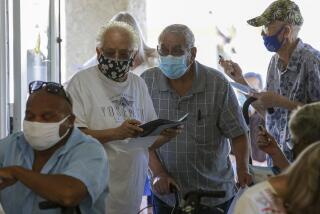HMO Care Is Rated Superior by Study : Medicine: The report, which looked at heart attack patients over age 55, said health maintenance organizations delivered better services than private doctors.
- Share via
Contrary to many expectations, older heart attack patients enrolled in health maintenance organizations received better medical care than similar patients treated by private doctors, according to a new study from the UCLA Medical Center and the Santa Monica-based RAND Corp.
The results, announced Saturday in Seattle at a meeting of the American Federation for Clinical Research, reinforce studies over the past decade. Previous findings have shown that relatively inexpensive prepaid health plans are capable of providing medical care that is as good as that provided by private doctors and hospitals.
But relatively few previous studies have shown that HMOs deliver better medical care.
The UCLA/RAND team discovered “major differences in the quality of care,” said Dr. David Carlisle, the principal author of the study. These differences included overall quality of care as well as specific areas, such as the quality of physician and nurse care.
Carlisle said employers as well as the public may eventually be able to use the UCLA/RAND quality-of-care measures when comparing different health plans. The findings also “raise the possibility” that HMOs may now be able to compete with private hospitals as well as other HMOs on the basis of quality, not simply cost, he said.
The findings for heart attack patients are particularly significant. Heart disease is the leading cause of death in the United States.
A heart attack occurs when heart arteries become blocked with fatty deposits and blood clots, thereby cutting off the blood supply to part of heart. Each year, about 1.5 million American have heart attacks and about 500,000 die.
Membership in the nation’s 569 HMOs grew by about 1.7 million in 1990, reaching 36.5 million at year’s end, according to industry statistics. In California, one in three people is enrolled in an HMO. The number of patients with private “fee-for-service” insurance is decreasing.
The HMO enrollees include more than a million patients covered by Medicare, the federal health insurance program for the elderly and disabled.
The team of seven researchers compared a sample of 369 heart attack patients from HMOs in three states to a national sample of 1,469 heart attack patients who received private medical care. All patients were over age 55 and enrolled in the federal Medicare program.
The HMOs were not identified. The patients were treated in 1985 and 1986.
The researchers used Medicare and other records to determine the death rates for patients at 30 days and 180 days after hospital admission. The death rates then were adjusted for differences in the sickness of patients when first admitted to the hospital.
Quality of hospital care was measured by an extensive review of patients’ medical records using standardized criteria.
The study found no significant differences in death rates between the HMO and private patients. The death rate was about 23% at 30 days and about 35% within 180 days.
Carlisle cautioned, however, that the project may have been too small to detect differences in death rates. A previous UCLA/RAND study, involving more Medicare patients, found that heart attack patients judged to have better physician and nursing care had significantly lower mortality rates than other patients.
In the new study, the HMOs had a significant edge for physician and nursing care and cardiac monitoring, Carlisle said. The private doctors and hospitals scored better on the appropriate use of diagnostic tests. The HMOs scored slightly better on the use of heart attack treatments.
One of the three HMOs studied also appeared to have significantly better quality of care for heart attack patients than the other two.
In recent years, the widespread use of drugs that dissolve blood clots, such as streptokinase and TPA, has improved the survival of heart attack patients. It is uncertain how this development would influence the results of a study conducted today, as these medications are widely used in all types of hospitals.





